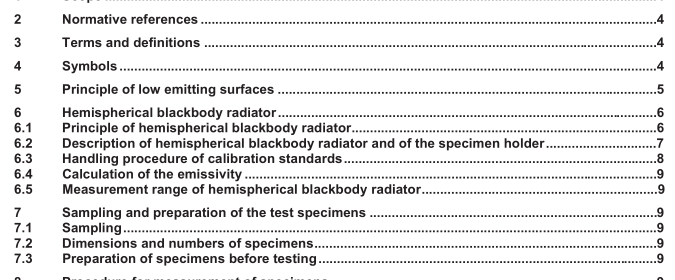EN 15976:2011 – Flexible sheets for waterproofing – Determination of emissivity

6.5 Measurement range of hemispherical blackbody radiator
The measurement range of the apparatus is limited to values between those of the two calibration standards used thus from emissivity range of 0,02 – 0,94.
7 Sampling and preparation of the test specimens
7.1 Sampling
A sheet sample of an undamaged roll shall be selected in accordance with EN 13416.
7.2 Dimensions and numbers of specimens
A minimum of five specimens should be taken with a regular spacing. The specimen size should be adapted to the size of the specimen holder and to the fixation system of the specimen holder (see 6.2).
7.3 Preparation of specimens before testing
The specimens should be kept for a minimum of 2 h at a temperature of 23 ± 2 °C and relative humidity of 50 ± 20 %. Special precaution should be taken to ensure that the calibration standards, the specimens and the apparatus are equilibrated in the same standard climatic conditions. Air currents and draughts in the measuring area must be avoided.
8 Procedure for measurement of specimens
The apparatus should be switched on at least 2 h before calibration and beginning measurements. The apparatus should be installed in a fixed position and must not be moved during measurement. The specimen is brought up to the apparatus in a vertical orientation, pressed firmly against the spacers around the measuring window of the apparatus and the apparatus is activated to begin measurement. In order to avoid that the specimen temperature changes during the measurement, the residence time of the specimen in the measuring position must be reduced to a minimum. Between specimen positioning and start of measurement, not more than 1 s shall pass.
If this speed of measurement is not achieved, if the measurement is otherwise interrupted or if the measurement on a specimen is to be repeated, the specimen should be withdrawn from the apparatus for the time it needs to cool down to laboratory temperature.
The higher the emissivity and/or the lower the specific heat capacity ( c ) of the material, the longer the specimen will need to cool down to laboratory temperature. In order to reduce measurement variability to a minimum (laboratory, specimen and apparatus related), after a time interval of maximum 1 h, the apparatus shall be recalibrated using the two calibration standards.
EN 15976:2011 – Flexible sheets for waterproofing – Determination of emissivity